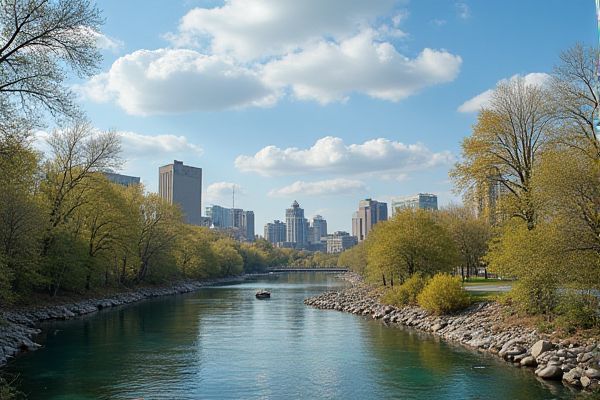
Weather and climate in South Dakota: Continental climate characteristics. Cold, snowy winters. Hot, humid summers. Rapid weather changes. Thunderstorm occurrence in summer. Tornado risk, mainly in spring. Average annual precipitation varies. Blizzards common in winter. Temperature extremes possible. Windy conditions year-round.
Continental climate characteristics.
South Dakota has a Continental Climate characterized by four distinct seasons, with cold, dry winters and warm, semi-humid summers. The state experiences significant temperature extremes, with summer highs often near 90°F (32°C) and winter lows below 10°F (-12°C), along with varying precipitation levels from semi-arid in the northwest to semi-humid in the southeast. For more detailed information about the climate and geographical features of the state, you can visit the Wikipedia page on South Dakota.
Cold, snowy winters.
South Dakota experiences cold and snowy winters, with average January highs below 32°F (0°C) and lows below 10°F (-12°C). The winter months from December to early March are ideal for winter sports, with significant snowfall and the possibility of blizzard conditions. For more detailed information on seasonal changes and activities, you can visit the Travel South Dakota website.
Hot, humid summers.
In South Dakota, summers are characterized by semi-humid conditions with average highs of 90°F (32°C) during the day and lows near 60°F (16°C) at night, especially from late May to early September. The state experiences 15 to 16 hours of daylight per day during this period, although thunderstorms can occur. For more detailed information about the seasons and weather patterns, visit the Travel South Dakota website to explore what each season has to offer in this remarkable state.
Rapid weather changes.
South Dakota is known for rapid and extreme weather changes, exemplified by the 1943 event in Spearfish where the temperature rose from -4°F to 45°F in just two minutes, setting a world record for the fastest temperature change. This phenomenon, caused by a warm chinook wind, highlights the state's susceptibility to sudden and dramatic weather fluctuations. For more details on this extraordinary event, visit the Spearfish's World Record Temperature Change page.
Thunderstorm occurrence in summer.
In South Dakota, summer is prone to severe thunderstorms, including derechos, which are long-lived, straight-line wind storms. The state experienced two unexpected derechos in the summer of 2022, highlighting an increase in the frequency of severe weather events, although the link to climate change is still being studied.
Tornado risk, mainly in spring.
South Dakota, particularly in the spring and early summer, experiences a significant tornado risk due to its location near Tornado Alley, where warm, moist air from the Gulf of Mexico collides with cool, dry air from Canada. Minnehaha County is notably vulnerable, ranking 51st in the U.S. for tornado vulnerability, with an average of thirty-six tornadoes per year statewide and a projected annual loss of around $32 million from tornadoes. For more detailed information, you can visit Minnehaha County's profile here, which further illustrates the challenges faced by this region.
Average annual precipitation varies.
Average annual precipitation in South Dakota varies significantly across the state, ranging from around 16 inches in the northwest to about 28 inches in the southeast, with specific cities like Sioux Falls receiving 27.9 inches and Lead receiving 31.8 inches annually. For detailed statistics on the area's rainfall, you can visit the Current Results website.
Blizzards common in winter.
Blizzards are a significant aspect of South Dakota's winter climate, with notable events like the January 1949 and March 1966 blizzards causing severe conditions, including high winds, deep snowdrifts, and significant temperature drops. These storms underscore the state's vulnerability to intense winter weather. For a deeper exploration of these historical events, visit the South Dakota Blizzards page, which provides detailed accounts and cultural reflections on the impact of these formidable natural phenomena. Such history is a testament to the resilience required to withstand South Dakota's extreme winter challenges.
Temperature extremes possible.
South Dakota experiences extreme temperature fluctuations, with the highest recorded temperature being 120°F on July 15, 2006, at Usta, and the lowest recorded temperature being -58°F on February 17, 1936, at McIntosh. Temperatures of 100°F or higher occur nearly every year, and subzero temperatures are common during winter months. For more detailed data on these climatic conditions, visit the South Dakota Temperature information page.
Windy conditions year-round.
South Dakota is one of the windiest states in the U.S., ranking sixth with an average wind speed of 20.3 mph. The state experiences consistent winds throughout the year due to its location in the center of the North American continent and its exposure to various wind patterns. For more detailed insights, visit this South Dakota article which explores the state's unique climate conditions.
